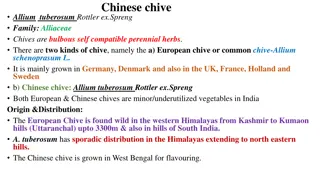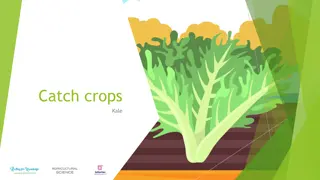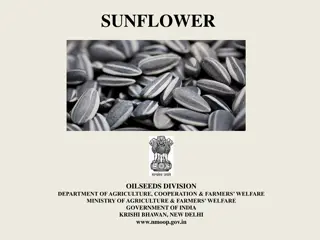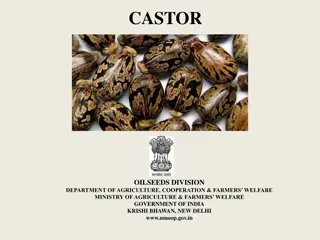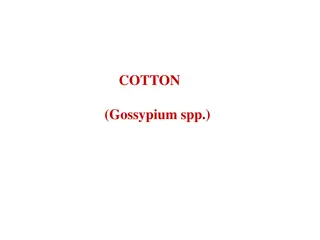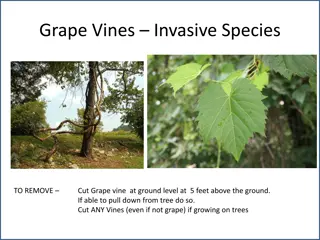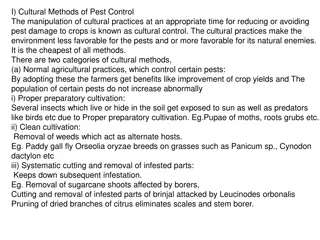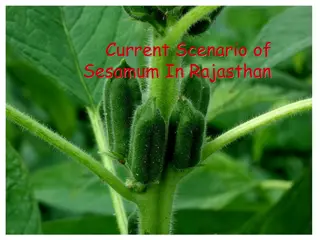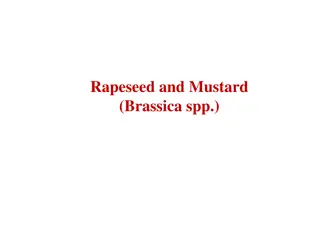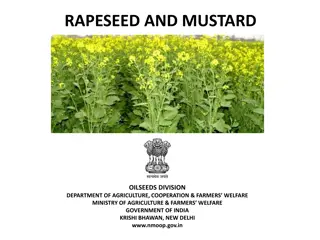Comprehensive Overview of Mustard Plant Cultivation
Mustard, scientifically known as Brassica indica, is a cool-season crop with origins in Europe. India leads in mustard production, with over 150 species primarily found in temperate regions. This versatile plant thrives in different soils and climatic conditions, offering a wide range of cultivation possibilities. Learn about its scientific classification, origin, morphology, and optimal growth conditions for successful mustard cultivation.
Download Presentation

Please find below an Image/Link to download the presentation.
The content on the website is provided AS IS for your information and personal use only. It may not be sold, licensed, or shared on other websites without obtaining consent from the author.If you encounter any issues during the download, it is possible that the publisher has removed the file from their server.
You are allowed to download the files provided on this website for personal or commercial use, subject to the condition that they are used lawfully. All files are the property of their respective owners.
The content on the website is provided AS IS for your information and personal use only. It may not be sold, licensed, or shared on other websites without obtaining consent from the author.
E N D
Presentation Transcript
Topic to be presented Topic to be presented MUSTARD MUSTARD Name Name- - Gungun Singh Regd. No Regd. No 210704170006 Branch Branch B.Sc. Zoology Subject Subject- - Economic botany
CONTENT CONTENT Introduction Scientific classification Origin Climate and temperature Soil Morphology Types of Mustard Forms of mustard and Use
INTRODUCTION It is originated native to temperate regions of Europe. One of the first domesticated crops. Major cultivating countries are Nepal, Canada, Myanmar, China and United States.
SCIENTIFIC CLASSIFICATION Scientific name Brassica indica Kingdom- plantae Order- brassicales Family Brassicaceae Genus Brassica Vernacular name Sarso, Rai
ORIGIN It originated In Europe. India occupies the first position for the production of mustard. It includes over 150 species which are mostly native to the north temperate parts of the world. These are centre of genetic diversity. Europe Central and southern Asia China Some different species have spread to the tropic and sub-tropics as cold season crops.
CLIMATE AND TEMPERATURE Mustard is a cool season crop that can be grown in a short growing season. Seedlings are usually somewhat tolerant to mild frosts after emergence, but severe frosts can destroy the crop. Moisture stress caused by hot , dry condition during the flowering period frequently causes lower yields.
SOIL Mustard can be raised on variable soil types with; Fertile Well drained Loamy soil
MORPHOLOGY Flower Actinomorphic flowers are present. These flowers contain four sepals , four petals 6 stamen superior ovary two carpels one pistil is present
LEAVES Leaves are opposite. No stipules are present. Net venation is seen .
Fruits The fruit is siliqua or silicula. It contains short and compressed pod . Many are slender and long. Seeds- Seeds are small , spherical, yellow brown to black in colour. Usually about 1 to 2mm in diameter. Seeds of brassica posses a glytocyte sinigrin and
TYPES OF MUSTARD There are 3 types of mustard 1) Black mustard 2) Brown Indian/ oriental mustard 3) White/Yellow mustard
Brown mustard It is known as oil seed crop in Indian sub-continent, Canada , Great prritain , Denmark, China, US , South ukarine. Yellow/ White Mustard- It comprises about 90% of countries like Europe, England and Netherland. Black mustard- It grown in Argentina, US, and some European countries. Mustard seeds are the production between 450000- 700000 tones annually in the world.
Forms of mustard and Use 1) Mustard Oil 2) Mustard Powder 3) Mustard Cream 4) Mustard Seeds
Medicinal Use Mustard is used as a food flavoring and as a forage crop. It has traditionally been used as an emetic and diuretic, as well as a topical treatment for inflammatory conditions such as arthritis and rheumatism. Relief from tried feet. Back ache treating bath . Sore throat relief. Medicinally, the essential oil of mustard is an extremely powerful irritant, causing severe blister of the skin. Cosmetic production Agrochemical production







